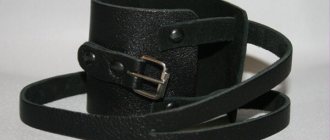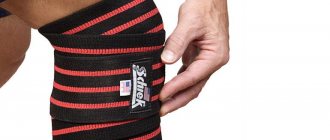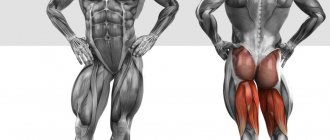Types of stops - how to choose
- Horizontal - straight stops in the form of handles; some companies make collapsible stops with varying height levels.
- Inclined - made with inclined handles, they can also be collapsible or stationary.
- Rotary – supports for push-ups, with the ability to rotate the hand while performing the exercise.
- Curved - a type of horizontal stationary stops in the form of a “snake”.
What to look for when choosing stops
- Racks must be made of high-strength plastic or metal.
- Rubberized stands should not slide on the floor surface.
- The material of the holders should be made of a durable but soft shell - neoprene, which increases grip comfort and maintains its integrity for a long time.
Manufacturers of stops
- Indigo is a Chinese manufacturer of stops made of durable steel and plastic that can withstand weights of up to 120 kg, with neoprene handles. Price about 505 rub.
- Push Up Pro – high strength swivel stops, can withstand loads up to 130 kg. Approximate price - 550 rubles.
- Power System - the brand offers multi-level collapsible stops, costing from 390 rubles.
- Torneo - they produce straight and curved stops with a soft neoprene coating. Withstands loads up to 100 kg. Cost from 799 rub.
- Kettler – stops include: steel, plastic, neoprene. The cost of goods from 1999 rubles.
DIY push-up supports
Many athletes try to save money and make their own accessory for push-ups. In addition, you can make your own simulator with the required parameters. The following inventions are popular among craftsmen:
- Two stacks of books of the same height at the required distance. This option does not relieve the stress on your hands, and there is also a risk that the books will simply slip on the smooth surface of the floor.
- Some make analogues of plastic store-bought exercise machines from pipes and plumbing fittings.
- Others use construction wood trowels, adding height if necessary by attaching wood panels underneath.
- You can make stops from wooden cylinders and trapezoidal posts if you have basic carpentry skills and tools.
Exercises with push-ups - what muscles work
Wide stance push-ups
This placement of the hands will allow you to work the chest muscles, developing the muscles in width; the higher the position of the stands, the stronger the lower chest works. If you put your feet on a bench or fitball, the upper part of the pecs works. The rear delta and triceps also develop.
- Grasp the supports with both hands, take the position of a plank, you can do push-ups from your knees. It is important to keep your entire body straight.
- Place your palms wide so that the handles are horizontal, in line.
- As you inhale, lower your chest to the floor as low as possible, if your muscles and joints allow. Bring your elbows out to the sides, at the level of the shoulder joints.
- As you exhale, push up from the supports.
Important! Keep your hand and forearm in the same plane, without twisting your hand , to prevent injury and excessive stress on the wrist joints.
To increase the complexity of the exercise , place your feet on a fitball (large ball) or put your feet into TRX loops; this technique will load all the small and deep muscles of the shoulder girdle, as well as the back and abdomen, which allow you to maintain balance. Take your time, keep your whole body in good shape, don’t hold your breath .
Narrow push-ups
are worked to a greater extent . You can also perform the exercise at different heights, both on a bench and on a ball.
- Place supports under the shoulder joints parallel to each other.
- Stand in a plank position (or push-ups from your knees), keep your back straight, tensing your abdominal muscles.
- As you inhale, bend your elbows, pressing them as close to your body as possible.
- Exhale and do push-ups.
Multi-grip push-ups
The combination of wide and narrow positioning of the arms simultaneously allows you to work all the muscles of the shoulder girdle.
- Grab the handles, take the position while lying down.
- Place your right hand further from the shoulder to the side, placing the hand horizontally.
- Place your left hand vertically under the shoulder joint.
- As you inhale, bend your elbows, moving your right elbow to the side and your left along your body.
- As you exhale, do push-ups with different grips without losing your technique. Complete the set for the required number of repetitions.
- Perform the same movement, changing hands.
Vertical push-ups
The technique with stops can be performed while standing on the floor at a 90-degree angle, also on a hill or against a wall. This technique mainly works the middle delta, pectoral muscles and triceps.
- Stand in a plank position, placing the supports wide, as in the first exercise.
- Raise your pelvis and step your feet forward slightly, forming a right angle between your torso and hips.
- The body and arms are in one line, without sagging in the chest.
- As you inhale, bend your elbows to the sides, imitating a dumbbell press upward, and slowly lower your head between the supports. The elbows should also form a right angle.
- Exhale and push up, keeping your elbows fully straight. The pelvis does not change position, the tailbone “stretches” towards the ceiling.
Reverse push-ups
In this version of push-ups, the front delta, triceps, and also the upper part of the pectorals work It is performed similar to reverse push-ups from a bench.
- Grab the supports and sit on your buttocks.
- Place your hands under the shoulder joints, turning the supports parallel to each other. Feet on the floor, hip-width apart.
- Raise your pelvis off the floor without touching your buttocks during push-ups.
- As you inhale, bend your elbows, moving them back. At the same time, the pelvis moves slightly forward towards the feet.
- Exhale, straighten your elbows, and return to the starting position.
Why do you need push-up supports?
In almost any sports store you can find special push-ups. This is a simple sports equipment consisting of a support and handles. Many models have special anti-slip pads at the grip area. With such emphasis during training, an imitation of push-ups occurs on fists, but with much greater variations and effectiveness.
This accessory is especially appreciated by athletes involved in workout. Why do you need push-up supports:
- They help to diversify your usual push-ups by only slightly changing the position of your hands.
- Due to the increase in the range of motion, proper stretching and concentration of tension occurs on the pectoral muscles.
- The simulator helps relieve increased stress from the wrist, which is important for an athlete, for example, with a large body weight.
Training principles
There are practically no differences from the classic ones. The only difference is that the athlete tightly grasps the handle, rather than placing his palm on the floor. By the way, this vertical position of the brush allows...
As with simple push-ups, the position of the palms and the distance between them are of great importance. For example, a narrow positioning of the supports is aimed at working the triceps. If you add an outward rotation of the hands, the emphasis will shift to the deltoids.
Thanks to the many variations in the use of supports, you can effectively work out your pectoral muscles, arms and shoulders, without visiting the fitness room. At the same time, trainers recommend not to neglect warming up and perform joint exercises even at home before simple push-ups.
What models exist
The most common are U-shaped stops. In the simplest case, it is a handle on two supports. There are variations of this model, when one of the supports is made shorter than the other, then the handle-bar is at a certain angle to the floor (the same as the body of the person performing push-ups). This form is considered more physiological.
Z-shaped models provide a stable support for push-ups.
There are more expensive products on the market with a swivel base. According to manufacturers, their products provide more intense muscle work with less stress on the joints. This is explained by the fact that when performing push-ups on rotary machines, more muscles are used, but the wrists, elbows and shoulders are always in a physiological position.
Read more: The most effective exercises for training legs for weight
Racks for push-ups and pumping the press
Hi all. I recently received push up racks. You've probably seen these in cool fitness centers or sports stores. And if you are far from sports, you may ask: why are they needed at all?! There are three reasons for this: 1) Convenience. Doing push-ups from soft and stable handles is much more pleasant than doing push-ups from the floor or, especially, from dumbbells. 2) You can do deeper push-ups. And the deeper you can go during push-ups, the more beautiful and defined pectoral muscles you can get. Of course, you can achieve the same result by simply doing push-ups with dumbbells or even bricks, but this is very inconvenient. And the dumbbells tend to move apart in different directions, which makes push-ups with additional weight simply impossible.
3) Security. By performing push-ups, you can stretch your hands, elbows, and wrists. Naturally, such problems do not arise with racks. Plus, the stands help relieve stress on your joints.
Package
The parcel arrived quite quickly (about 10 days). It was packed in pleasant white paper on which my name and surname were proudly displayed.
The slight aesthetic crease in the packaging made me worry, however, upon opening the box, I immediately calmed down: the racks were safe and sound. Although no, intact, but disassembled.
Well, now, let's take a closer look at our product. Since I ordered the most expensive model on the site, it has several features. The first is the presence of a crossbar. The second is the presence of a suction cup that is attached to it.
The suction cups firmly stick to any smooth surface, which makes it possible to do push-ups from a chair, table, wall refrigerator - in general, from anything that our imagination can handle. And according to the manufacturers’ idea, by inserting your legs under the racks you can also pump up your abs. We collect
Depending on what we will be doing, we can assemble the racks either with suction cups or without.
If you are not pumping up your abs, then it is better not to install suction cups, because it is really difficult to tear them off the floor. Any design option is fastened with the following bolts for strength:
Doing push-ups
Now let's move on to the most interesting part - push-ups. Doing push-ups with these racks is pleasant not only because of their rounded shape, but also thanks to the soft foam handles. And if your palms get sweaty, the handles will prevent them from sliding down.
I was a little disappointed that the handles themselves are made of plastic. Although, it should be noted that the plastic is really harsh, I would say - Chelyabinsk. According to the manufacturer, the racks can withstand loads of up to 90 kg. And I am inclined to believe them, since they “endure” my 70s without complaint.
The only drawback of the purchase is that the left pillar bends slightly under my weight. But this doesn't make the weather.
Overall, I'm pleased: I got an excellent upper body trainer.
“Do a hundred push-ups against all odds” OR how to do 100 push-ups
For many people, performing a proper push-up, let alone doing 100 push-ups, can be extremely difficult.
But, if you want to get stronger, then this 12 week plan will help you. In fact, it will help you learn to do 100 push-ups without stopping in 12 weeks!
The difference between this plan and the previous one is that here you perform the movement consistently and smoothly, without paying attention to technique.
I recommend this plan for those who are able to perform at least one full push-up. If you are still working on it, then it is too early for you to use this training plan.
You probably think it's impossible to do 30 or 50 push-ups, let alone 100 in one set, but trust me, anyone can do it! All you need is the right training plan and repetition.
Let's move on to the diagram of how to do 100 push-ups, starting with one repetition per set. You are ready?
| Mon | W | Wed | Thu | Fri | Sat | Sun | |
| Week 1 | 5 x 1 | 5 x 1 | Rest | 4 x 2 | 4 x 2 | Rest | 4 x 3 |
| Week 2 | 5 x 2 | 5 x 2 | Rest | 4 x 3 | 4 x 3 | Rest | 4 x 4 |
| Week 3 | 4 x 5 | 4 x 6 | 4 x 6 | Rest | 3 x 8 | 3 x 9 | 3 x 10 |
| Week 4 | Rest | 2 x 12 | Rest | 3 x 10 | Rest | 4 x 8 | Rest |
| Week 5 | 2 x 15 | 2 x 16 | Rest | 3 x 15 | 3 x 15 | Rest | 4 x 10 |
| Week 6 | 2 x 20 | 2 x 22 | Rest | 3 x 20 | 3 x 20 | Rest | 2 x 25 |
| Week 7 | 4 x 18 | 4 x 20 | Rest | 2 x 38 | 2 x 40 | Rest | 3 x 30 |
| Week 8 | Rest | 3 x 55 | Rest | 4 x 30 | Rest | 5 x 25 | Rest |
| Week 9 | 2 x 45 | 3 x 45 | Rest | 2 x 50 | 3 x 50 | Rest | 2 x 60 |
| Week 10 | 3 x 55 | 4 x 50 | Rest | 3 x 60 | Rest | 2 x 65 | 3 x 65 |
| Week 11 | 2 x 70 | 4 x 65 | 2 x 80 | Rest | 2 x 80 | 3 x 75 | 2 x 85 |
| Week 12 | Rest | 2 x 90 | Rest | 2 x 95 | Rest | 3 x 90 | 1 x 100 |
The same training table in the picture to download to your computer.
How to use this program
In the 12-week push-up program, each workout is described by the numbers "2 x 10", for example.
- First digit = number of approaches
- Second digit = number of repetitions
The shorter your rest between sets, the better, but in later weeks, when you have to do almost 100 push-ups for a certain number of sets, increasing the rest time is simply necessary. There is no need to take a long break. Rest 5 minutes between sets to complete the required number of sets and reps.
If you cannot complete the target number of repetitions in one set, give yourself a few seconds to rest and continue until you complete everything.
I repeat, this program is for those who can do at least one push-up. It is designed specifically for beginners. If you do everything as expected, then by the end of week 12 you will be able to perform up to 100 repetitions.
Options for push-ups[edit | edit code]
If you successfully completed 100 push-ups in a row, either during the initial test (yes, it happened!) or after completing one of the six training programs, the giddy feeling of success has probably made you a fan of this exercise, and now you can't wait to challenge yourself even more target. If you want a little variety in addition, then choose some more difficult types of push-ups, which will provide you with an increased load in your workout and allow you to work different parts of the body.
Of course, you may limit yourself to maintaining your newfound strength and physical fitness, in which case there is simply no need for you to get acquainted with the next part of the book.
On the following pages you will find detailed step-by-step descriptions of the most popular varieties of push-ups of increased difficulty. Take the time to review the instructions and study the charts that show which areas of the body each exercise variation helps develop.
Once you find a pushup variation that suits you, do an initial test. The procedure is described on page 34 and, in fact, is no different from what you did before starting one of the progressive training programs: Beginner Level No. 1 and 2, Intermediate Level No. 1 and 2, or Advanced Level No. 1 and 2. The only difference from traditional push-ups will be that you will need simple sports equipment like a fitball or yoga ball, medicine ball or BOSU balance platform.
There is no limit to the strength and stability gains that can be achieved by regularly performing push-ups. Just like with most other forms of exercise, the key to success is consistency and continuity in the training process. However, if you get a little bored with traditional push-ups, the following movements of increased difficulty and complexity will help increase your interest in training and make it easier to stay motivated.
Advantages and disadvantages
The key beneficial feature of stops is that they add variety to your workouts. To grow muscles, you need to periodically change your exercise program. This is due to the adaptation of muscles to the same type of load, which leads to a stop in progress. In this situation, athletes either increase the weight of the exercises or change elements of the training plan.
The use of supports in classic push-ups allows you to effectively influence the target muscles and stimulate their growth.
The disadvantages of projectiles include an increased risk of injury. The supports increase the amplitude of lowering the body during push-ups, which creates an additional tensile load on the shoulder joints.
If an athlete does not have good extensibility of the joint ligaments, he may get injured.
Therefore, push-ups are not recommended for beginner athletes and girls. First, you should practice the classic technique - with your palms on the floor - and only then move on to more complicated variations.











